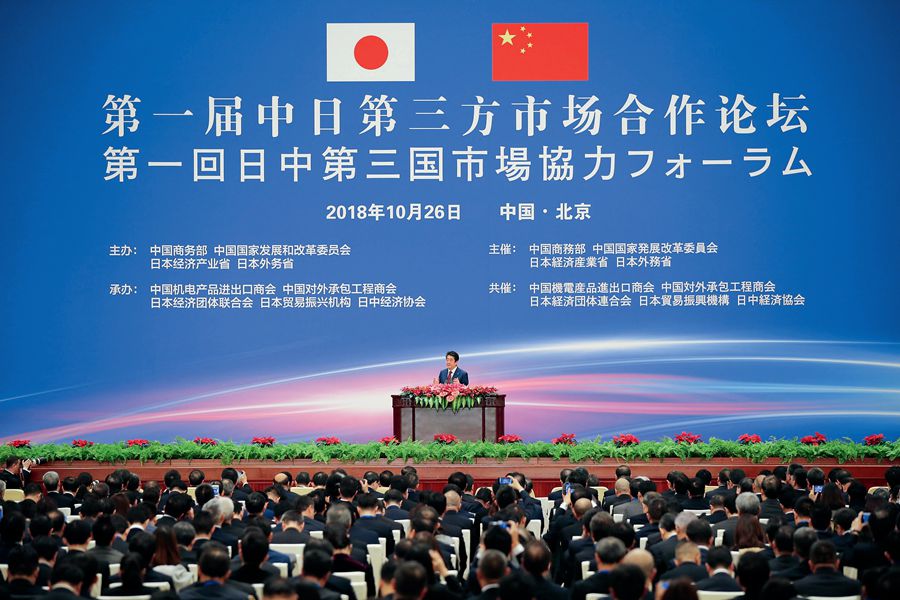
Japanese Prime Minister Shinzo Abe gives a speech at the First China-Japan Third Party Market Cooperation Forum on October 26, 2018.
To date, similar consensuses have been reached between China and a couple of Western and Asian countries including France, South Korea, Germany, U.K. and Japan to work this way in areas of infrastructure, energy, environmental protection, and economy. It sets new examples of cross-border cooperation, and is of vital significance for all parties involved: it promotes the development of China’s industries, enhances the industrialization and economic development in developing countries, and helps developed countries to open up new markets. From the point of view of the Belt and Road Initiative (BRI) construction, it embodies the BRI principle of achieving shared growth through discussion and collaboration and offers ways to solve the structural flaws of BRI cooperation.
Risk Reduction for BRI Economic Cooperation
Over the past five years, economic cooperation along the Belt and Road routes is both fruitful and problematic. On the one hand, cooperation is broadening and deepening in areas such as co-investment in large projects, the construction of overseas cooperation zones and free trade zones. On the other, systematic risks and concrete challenges are inevitable against the background of a sluggish global economy and the mismatch between supply and demand in different regions of the world.
In terms of systematic risks, the picture is gray. Negative impacts of the global financial crisis still linger: the world economy remains sluggish; and protectionism and anti-globalization sentiment is on the rise. Some developed countries, in order to revitalize their own economies, promote reindustrialization and encourage manufacturing and the return of huge amounts of capital from transnational enterprises. At the same time, they seek to introduce more protectionist measures. Under such circumstances, there may be more fierce trade wars, currency wars, and commodity price wars, posing more risks for emerging economies.
Concrete challenges are mainly about funds, technologies, and the competition and complementarity between different industries. Most of the developing countries along the Belt and Road routes are at the primary level of industrialization, and in great need of infrastructure construction and industrial development, but they do not have the technology and funds to achieve that. While to developed countries, despite their advanced technologies, insufficient domestic capacities brought about by the hollowing-out of their manufacturing industries, lead to high costs in exploiting the third-party market.
This innovative cooperation model is a win-win opportunity for all. Western countries trade their advanced technologies and concepts for more financing support and more overseas markets. The third-party markets get parts of what they have long desired: competitive and cost-effective products and services, at the cost of opening up their markets. And China enters more overseas markets to export its abundant industrial capacities.
Third-party market cooperation balances the supply and demand of countries at different stages of development in the world, and promotes the organic integration of high- and low-end industries in the world. It is hoped that in a broader sense, a more reasonable and efficient “industrial division of labor,” and an integrated industrial chain around the world will come into being.
A Boost to China’s Further Reform and Opening-up
The third-party market cooperation will be a new platform for China’s further reform and opening-up. It’s advisable to set up a special learning mechanism devoted to study Western countries’ experiences in investment, project management, basic research, and the service industry.
Besides a learning mechanism, more communication channels should be created to facilitate the exchange of views between China and the Western countries in technological advances, brand management, and project investment.
Japan is a good example. The coordination mechanism between the Japanese government and its private sectors, the combination of economic investment and cultural exchanges, the integration of vertical and horizontal investment, investment and financing experiences, as well as the internationally renowned quality of Japanese infrastructure projects, are all exemplary. When China makes plans in third-party markets, all the above experiences are worth learning.
Cooperation in key fields in third-party markets is another focus. The preliminary cooperation is mainly launched in infrastructure and industrial capacity. In the future, more areas such as environmental protection, health-care services, aerospace industry, and high-speed railway construction, are expected to be included.
Chinese enterprises are in the employment of global strategies, and are practical, innovative, and capable in market creation; while Western companies are advanced at basic innovation. Both sides can learn from each other’s strengths.
Specifically, health-care services could be a key area for Sino-Japanese cooperation in the BRI countries. Japan’s expertise in caring for the elderly can be brought by China’s company to countries along the routes benefitting the people in need.
Supporting Real Economy
In order to strengthen financial support to lower investment risks during cooperation in third-party markets, co-invested funds should be set up jointly by the China Development Bank (CDB) or the Silk Road Fund and foreign financial institutions; innovative financing methods such as the combination of public and private funds are also in need. Besides, parallel loans, equity investment, risk participation, technical assistance, and other forms of cooperation all provide financing support, which is a boost to long-term sustainable cooperation.
President Xi Jinping stressed, “Finance is the blood of the real economy. Serving the real economy is the mission of finance and the fundamental measure to prevent financial risks.” In third-party market cooperation, the financial system should truly serve and promote the real economy.
Cooperation in third-party markets embodies China’s global governance concept of achieving shared growth, its ideal of building a community with a shared future for mankind and the Silk Road spirit of “peace and cooperation, openness and inclusiveness, mutual learning, and mutual benefit.”
It is also a new attempt to cope with the global economic challenges. To the BRI construction, it injects new vitality and provides new possibilities.
WU HAO is an executive director of the Silk Road Research Institute of Beijing Foreign Studies University.